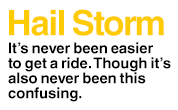New York Magazine startups

|
(Photo: Bobby Doherty/New York Magazine) |
Until very recently, if you wanted a taxi, there was one way to get it: Go outside and stick your hand in the air. The business of the yellow cab hadfrom a passenger standpoint, at leastchanged markedly little since 1937, when the medallion system came into use. Since then, the city has required that cabs have permits bolted to their sheet metal, and the majority of those medallions are in the hands of big taxi fleets. The business is so tightly regulated that these companies can seem state-owned, except for the fact that they make a lot of money. (One of the great art collections of the mid-20th century was assembled by taxi magnate Robert Scull.) The city has added a few medallions over the years, but not many; their essentially fixed quantity has driven prices past million apiece, making their owners disinclined to risk. The fleets’ only significant change to the business model has been to shift their drivers from staff to hired-gun status, thus eliminating their benefits, some of which were later regained through unionization. A generation ago, drivers drove eight-hour shifts and earned passable middle-class wages. Today, after driving 12 hours and paying for gas and the odd parking ticket, a full-time fleet driver earns a bare-bones incomeon the order of $35, 000 per year. Neither passenger nor driver nor cabbie nor fleet owner fundamentally altered the exchange: Raise arm, pull over, drive to destination, exchange cash.
The fleets’ only significant change to the business model has been to shift their drivers from staff to hired-gun status, thus eliminating their benefits, some of which were later regained through unionization. A generation ago, drivers drove eight-hour shifts and earned passable middle-class wages. Today, after driving 12 hours and paying for gas and the odd parking ticket, a full-time fleet driver earns a bare-bones incomeon the order of $35, 000 per year. Neither passenger nor driver nor cabbie nor fleet owner fundamentally altered the exchange: Raise arm, pull over, drive to destination, exchange cash.
Well, as they teach in business school: If a system has chugged along, making money without challenge for decades, change will be dramatic when it does come. So it has gone with the taxicab business. The smartphone, paired with onboard electronics, opened a back route into this formerly closed world, and the yellow taxi suddenly finds itself among many other cars of unfamiliar colors.
You might also like


Patient care tech VerbalCare wins $15k in Fenway Fast Pitch — Boston Business Journal
Boston startup Verbal Applications, maker of a patient engagement software called VerbalCare, took home $15,000 in a competition at Fenway Park on Thursday that pitted three Boston startups against three New York City startups.

|
Corkers - DIY Wine Cork Animal Puzzle Stylish Decorative Bunny Design Kitchen (4,18,79)
|



